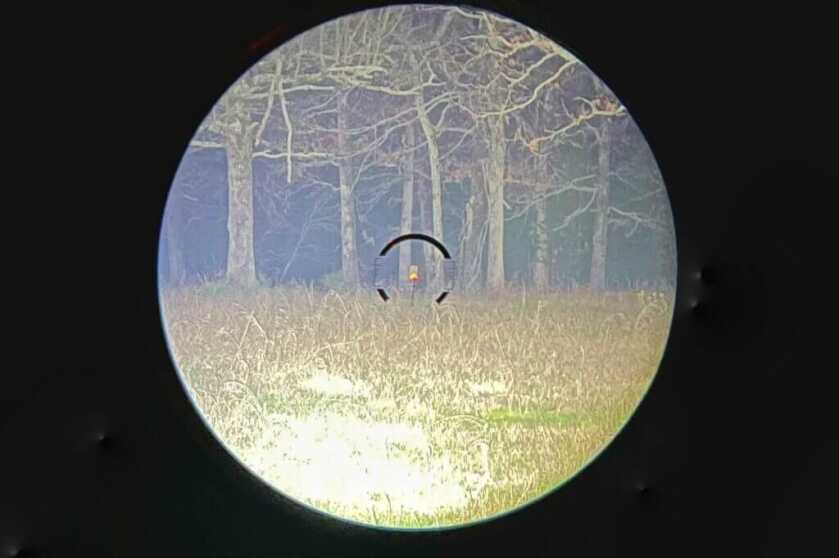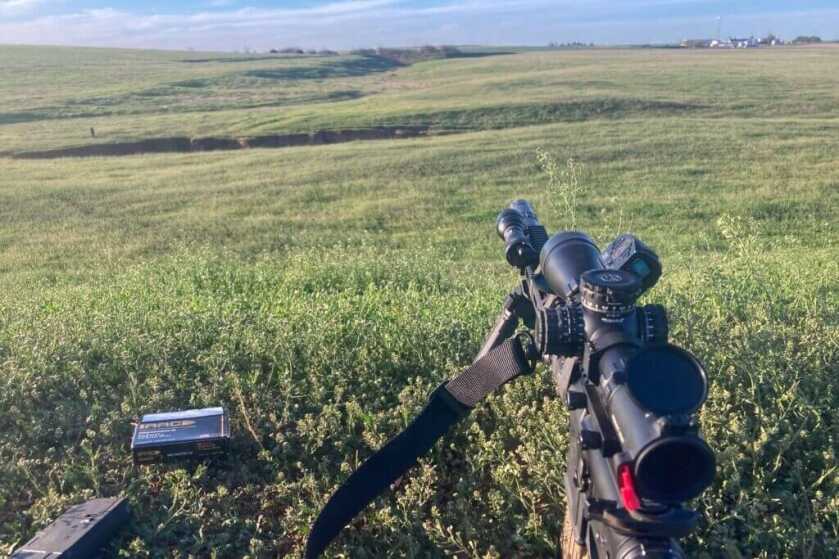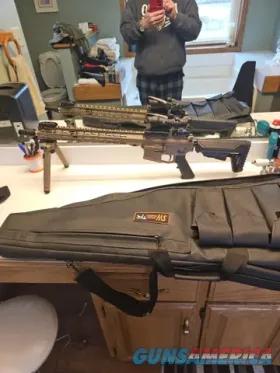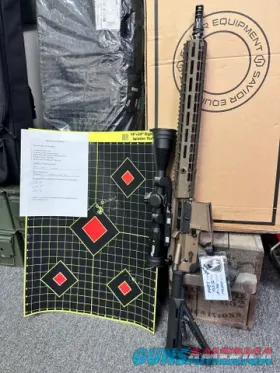
Estimated reading time: 9 minutes
Striking a balance between performance and form, does Primary Arms’ GLX 2.5-10 have the muscle to hold its own on an SPR?
Table of contents
Preface
A few months ago I got the itch to explore the SPR concept and put together a rifle to fill that role in my arsenal. In the broadest definition, an SPR (Special Purpose Rifle) is an AR-15 built to be effective at longer ranges than your average GPR (General Purpose Rifle). For reference, my general-purpose rifle is a 14.5” outfitted with a 1-8 LPVO, offset red dot, white light, and an IR laser.
75% of the time my 14.5” is exactly what I need and the rest of the time it can usually get the job done. The areas where my 14.5 isn’t ideal are at extremely close or long range. Working in and around cars with a suppressed 14.5” is doable but something shorter would be nice. On the opposite end of the spectrum, I can make hits at 500 yards with my 14.5” but it feels like I’m pushing its limits and my hits aren’t as consistent as I would like.
I created the graphic below to explain my view of the relationship between Short Barreled Rifles, General Purpose Rifles, and Special Purpose RIfles in terms of what ranges they are best suited for.

Five hundred yards is the maximum distance I shoot on a semi-frequent basis, so my goal for building an SPR is to have a more effective rifle at that range. Knowing that my goal isn’t to shoot super long-range determines two key components that differ from many SPR builds.
Available on GunsAmerica Now
First, I opted for a sixteen-inch barrel instead of the typical eighteen. Sixteen inches provides enough velocity for my distances and I don’t want this rifle to be needlessly long.
Second, the range limitation means I don’t need a high-power scope. A light Mid Power Variable Optic (MPVO) will suit this rifle nicely.
Enter The PA GLX 2.5-10
There aren’t a ton of options when it comes to MPVOs but there are a few popular units. One of which is the Primary Arms GLX 2.5-10.

Often the first question people ask is why not just get a 1-10 and have more usability at the lower end of the magnification range? That is certainly a fair question and one I hope to answer but first, here are the general specs for the GLX 2.5-10.
- 2.5-10x Magnification
- 44mm objective
- 2.7″ – 2.8″ of eye relief
- 30mm main tube
- One-piece 6061-T6 aluminum body
- 12.5″ long
- 22.2 ounces
Parallax Adjustment
The lack of parallax adjustment is probably the biggest issue when using an LPVO for long-range shooting. The vast majority of LPVOs are designed to be parallax-free somewhere around one hundred yards but don’t offer the ability to adjust for other distances.
Having the parallax set for the distance you’re shooting means that no matter where your eye is behind the scope, the reticle will stay true to the point of impact. Inversely, if you are shooting at a distance that the parallax is not adjusted for then your eye placement behind the scope becomes crucial as the slightest movement may affect your shot placement.

To clarify, parallax errors don’t make a huge difference in most situations. But since we are building a precision-oriented rifle, a few inches of error at five hundred is something I would rather avoid. Thankfully, the PA 2.5-10x GLX comes with parallax adjustment. The knob is located on the left side of the optic opposite the windage turret. It adjusts smoothly from twenty-five yards to infinity.
Light Transmission
Another benefit of the MPVO over the LPVO is better light transmission. This scope is plenty bright in the late evening, early morning, and even while being used with a flashlight. I attribute this to the larger objective lens and lower magnification range.
Just like the big window in your living room lets more light in the house than the tiny one above the shower, the 44mm objective lens on the GLX 2.5-10 produces a brighter image than the 24mm objective found on most 1-10s.
Compared to the LPVO, the MPVO has to do way less optical gymnastics to reach its maximum power. For the MPVO to reach 10x it only has to multiply its base magnification by four. On the other hand, the LPVO must multiply its base magnification by ten. Increasing magnification by such a large factor requires more complicated optics leading to a darker and sometimes more distorted image.
Windage and Elevation of the GLX 2.5-10
Another benefit of this scope over most LPVOs is that it is easily adjustable for both windage and elevation. This gives the option to dial in your dope vs holding over the target. The turrets are easy to use and adjustment clicks feel well-defined without sounding like a ratchet. There is a zero stop on the elevation and both turrets automatically lock in the zero position.

To unlock the turrets simply press the unlock button before making your adjustment. The turret size is large enough to make manipulation easy without adding too much bulk to the scope.
ACSS Raptor-M2 Reticle
If dialing in holds isn’t for you, the Raptor reticle featured in this scope makes holding over easy. Included in the reticle are tools for ranging targets, holds for five and ten-mile-per-hour wind, and bullet drop compensation out to eight hundred yards.

I am usually skeptical of BDC reticles because they never seem to match up with the actual drop of my rounds but this scope is pretty close. 77gr OTM from my 16” barrel was nearly dead on with the BDC out to four hundred. At 500 yards I found that I had to hold a few inches high but maybe some faster 62gr will better match the BDC. That will be a test for the next range trip.
Illumination
On this scope, the only portion of the reticle that is illuminated is the center chevron. I’m happy they chose to just illuminate this small portion vs the entire reticle. It provides enough light to distinguish your point of aim without washing out the rest of the image.

The control for the illumination is found on the same turret at the parallax adjustment. There are ten brightness settings with an off position between each one. Having the off position between each brightness level is quite handy. There is no need to twist through every setting to turn the optic off. Plus, when you go to turn it back on, you will be right next to the last setting you used.
Illumination can be handy but honestly, I rarely use it. I would have preferred they forgone the feature, cut a few bucks off the price, and made the parallax adjustment turret shorter having deleted its second function.
Magnification
Adjusting the magnification is smooth and consistent. The adjustment ring has raised knobs and a short tab to give some extra grip. This tab can be moved to a variety of positions on the adjustment ring to suit your preferences.
This is a First Focal Plane optic meaning the reticle changes size as you change the magnification. Thanks to this the BDC holds will be accurate no matter what magnification you have the scope on.

I have listed a few benefits the MPVO has over the LPVO but the question remains; why not get a more powerful scope like the 3-18 GLX that also has these benefits? That answer boils down to the relationship between size, weight, magnification, and the balance you find between them.
READ MORE: Primary Arms Optics Launches New Binos Line with SLx and GLx 10x42mm Models
I would love to have 18x on my rifle but for my purposes, it isn’t worth the extra 7.4 ounces of weight and 1.2 inches in length.
Final Thoughts On the GLX 2.5-10
The GLX 2.5-10 has served my purposes well. I was worried that 10x would be a little weak at five hundred yards but I had no issue making consistent first-round hits and calling shots for others. I may look for more magnification in the future if I start shooting further, but for now, this optic is perfect.
These scopes are currently going for $750 on Primary Arms’ Website which seems reasonable. I have seen them run promos for free shipping or a free mount so keep an eye out for those deals.
*** Buy and Sell on GunsAmerica! ***











